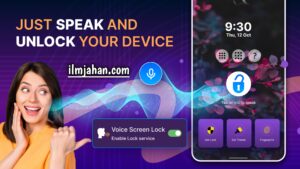Best Voice Lock For Android & Iphone- In the era of digital innovation, technology continues to redefine the way we interact with our devices. One such advancement gaining traction is Voice Screen Lock technology. This cutting-edge feature not only enhances security but also offers convenience, revolutionizing the way we protect our digital assets.
Voice Screen Lock
In this article, we delve into the intricacies of Voice Screen Lock, exploring its functionality, benefits, and its potential impact on the future of device security.
Understanding Voice Screen Lock
Voice Screen Lock is a biometric security feature that utilizes voice recognition technology to grant access to devices such as smartphones, tablets, and computers. Unlike traditional methods like PINs or passwords, Voice Screen Lock adds an extra layer of security by authenticating users based on their unique vocal patterns.
How Voice Screen Lock Works
Upon activation, Voice Screen Lock prompts users to enroll their voice by speaking a specific passphrase or set of words. These utterances are then processed and stored securely within the device’s system. When attempting to unlock the device, users are required to repeat the predefined passphrase. The device’s microphone captures the spoken words, which are then analyzed by sophisticated algorithms to verify the user’s identity. If the voice matches the stored pattern, access is granted, otherwise, the device remains locked.
Benefits of Voice Screen Lock
Enhanced Security: Voice Screen Lock offers a higher level of security compared to traditional methods like PINs or passwords. Since each individual has a unique voiceprint, the likelihood of unauthorized access is significantly reduced.
Convenience: Gone are the days of struggling to remember complex passwords or worrying about forgetting your PIN. Voice Screen Lock provides a seamless and convenient way to unlock devices, simply by speaking a passphrase.
Accessibility: Voice recognition technology makes devices more accessible to individuals with disabilities, particularly those with limited dexterity or visual impairments. This inclusivity aspect is a significant stride towards creating technology that caters to diverse user needs.
Quick Authentication: Voice authentication is typically faster than entering a PIN or password manually. With Voice Screen Lock, users can unlock their devices swiftly, streamlining the user experience.
Challenges and Considerations
While Voice Screen Lock technology offers promising benefits, it’s not without its challenges and considerations:
Accuracy: Ensuring accurate voice recognition across various accents, languages, and environmental conditions can be challenging. Developers must continually refine algorithms to improve accuracy and prevent false positives or negatives.
Privacy Concerns: Storing voice data raises privacy concerns, as it involves capturing and processing sensitive biometric information. Manufacturers must implement robust security measures to protect user data from unauthorized access or breaches.
Environmental Factors: External factors such as background noise or voice alterations due to illness may affect the accuracy of voice recognition. Devices must be equipped with noise-canceling technology and adaptive algorithms to mitigate these issues.
Future Implications
As Voice Screen Lock technology evolves, its applications extend beyond personal devices. Industries such as banking, healthcare, and automotive are exploring its potential for secure authentication and user verification. Additionally, the integration of artificial intelligence (AI) algorithms promises to enhance the accuracy and reliability of voice recognition systems further.
Integration with Smart Home Devices
Voice Screen Lock technology is not limited to smartphones and computers. With the rise of smart home devices, such as smart locks and home assistants, Voice Screen Lock can be seamlessly integrated into these systems. Imagine arriving home and simply uttering a passphrase to unlock your front door or verbally commanding your home assistant to perform tasks, all while maintaining a high level of security.
Potential for Multi-factor Authentication
Incorporating Voice Screen Lock as part of a multi-factor authentication (MFA) strategy enhances security even further. By combining voice recognition with other authentication factors such as fingerprint scans or facial recognition, organizations can create robust authentication mechanisms that significantly reduce the risk of unauthorized access.
Enterprise Applications
Enterprises are increasingly recognizing the value of biometric authentication, including Voice Screen Lock, in securing corporate devices and sensitive data. Voice authentication can replace or supplement traditional password-based authentication methods, reducing the risk of password-related security breaches such as phishing or credential theft.
Continual Advancements in AI and Machine Learning
The future of Voice Screen Lock technology hinges on advancements in artificial intelligence (AI) and machine learning. These technologies enable voice recognition systems to adapt and improve over time, enhancing accuracy and reliability. Through continuous learning from user interactions and feedback, Voice Screen Lock algorithms can better understand and distinguish individual vocal patterns, further bolstering security.
Regulatory Compliance and Data Protection
As with any biometric authentication technology, Voice Screen Lock must adhere to stringent data protection regulations, such as the General Data Protection Regulation (GDPR) in Europe or the California Consumer Privacy Act (CCPA) in the United States. Manufacturers and developers must prioritize user privacy and implement robust security measures to safeguard voice data against unauthorized access or misuse.
User Acceptance and Adoption
The widespread adoption of Voice Screen Lock technology hinges not only on its technical capabilities but also on user acceptance and trust. Educating users about the benefits and security features of voice authentication, as well as addressing any concerns regarding privacy and data protection, is crucial for fostering widespread adoption.
Voice Screen Lock technology represents a significant leap forward in the realm of device security and user authentication.
Its blend of convenience, security, and accessibility positions it as a compelling solution in an increasingly digitized world. While challenges persist, ongoing advancements in voice recognition technology hold promise for a future where unlocking devices is as simple as speaking a few words. Embracing Voice Screen Lock not only enhances security but also heralds a new era of seamless interaction with our digital devices.

